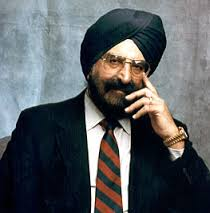
Narinder Singh Kapany (born 31 October 1926) is an Indian-born American Sikh physicist known for his work in fibre optics. He was named as one of the seven 'Unsung Heroes' by Fortune in their 'Businessmen of the Century' issue (1999-11-22). He is also known as "Father of Fiber Optics". The term fibre optics was coined by Singh Kapany in 1956. Kapany was born to a Sikh family in Moga, Punjab, and studied at Agra University. He served briefly as an Indian Ordnance Factories Service officer, before going to Imperial College London in 1952 to work on a Ph.D. degree in optics, which he obtained in 1955.
Kapany coined the term 'fibre optics' in an article in Scientific American in 1960, wrote the first book about the new field, and was the new field's most prominent researcher, writer, and spokesperson. Kapany's research and inventions have encompassed fibre-optics communications, lasers, biomedical instrumentation, solar energy and pollution monitoring. He has over one hundred patents, and was a member of the National Inventors Council. He has received many awards including 'The Excellence 2000 Award' from the USA Pan-Asian American Chamber of Commerce in 1998. He is an International Fellow of numerous scientific societies including the British Royal Academy of Engineering, the Optical Society of America, and the American Association for the Advancement of Science.
As an entrepreneur and business executive, Kapany has specialised in the processes of innovation and the management of technology and technology transfer. In 1960, he founded Optics Technology Inc. and was chairman of the board, President, and Director of Research for twelve years. In 1967 the company went public with numerous corporate acquisitions and joint-ventures in the United States and abroad. In 1973, Kapany founded Kaptron Inc. and was President and CEO until 1990 when he sold the company to AMP Incorporated. For the next nine years, Kapany was an AMP Fellow, heading the Entrepreneur & Technical Expert Program and serving as Chief Technologist for Global Communications Business. He recently founded K2 Optronics. He has also served on the boards of various companies. He was a member of the Young Presidents Organization and later was a member of the World Presidents Organization.
As an academic, Kapany has taught and supervised research activity of postgraduate students. He was a Regents Professor at the University of California, Berkeley (UCB), and at the University of California, Santa Cruz (UCSC). He was also Director of the Center for Innovation and Entrepreneurial Development (CIED) at UCSC for seven years. At Stanford University, he was a Visiting Scholar in the Physics Department and Consulting Professor in the Department of Electrical Engineering.
As an author and lecturer, Kapany has published over 100 scientific papers and four books on opto-electronics and entrepreneurship. He has lectured to various national and international scientific societies.
As a philanthropist, Kapany has been active in education and the arts. He was the founding chairman of the Sikh Foundation has been a major funder of its activities for over 50 years. In collaboration with international institutions and publishers, the Foundation runs programs in publishing, academia and the arts. In 1998, Kapany endowed a Chair of Sikh Studies at the University of California, Santa Barbara. His gift in 1999 of $500,000 to the Asian Art Museum of San Francisco will establish a gallery in its new building displaying the works he has donated from his collection of Sikh art. In 1999, he endowed a Chair of Opto-Electronics at the University of California, Santa Cruz. He is also trustee of the University of California, Santa Cruz Foundation. He has served as a trustee of the Menlo School in Menlo Park, California.
As an artist, Kapany has created 40 "dynoptic" sculptures which were first displayed in a one-man show at the Exploratorium of the Palace of Fine Arts in San Francisco in 1972. Since then, the collection has been viewed at museums and art galleries in Chicago, Monterey, Palo Alto, and Stanford.
Please view the links below to know more about this unsung amazing man.

